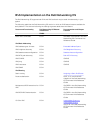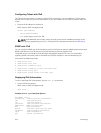Configuring the LPM Table for IPv6 Extended Prefixes
The LPM CAM table consists of two partitions: Partition I for IPv6 /65-/128 route-prefix entries and
Partition II for IPv6 0/0-/64 and IPv4 0/0-0/32 route-prefix entries. You must reconfigure LPM CAM to
allow IPv6 /65-/128 route prefixes to be stored in Partition I.
• Use the cam-ipv6 extended-prefix command to enable IPv6 /65-/128 route prefixes to be stored
in LPM CAM Partition 1. You must specify the maximum number of IPv6 prefixes with /65-/128 mask
length that are supported in the partition. The valid values are 1024, 2048 or 3072 prefixes. You must
save the configuration and reload the switch for the change to take effect.
• The number of entries in Partition II is reduced as the number of entries in Partition I increases.
• To disable LPM CAM partitioning and return the number of the IPv6 /65-/128 route prefixes stored in
Partition 1 to 0, enter the no cam-ipv6 extended-prefix command.
• Use the show cam-ipv6 extended-prefix command to display the currently configured number
of IPv6 /65-/128 prefixes that can be stored in LPM CAM Partition 1 and the number that are
supported after the next switch reboot.
ICMPv6
ICMP for IPv6 (ICMPv6) combines the roles of ICMP, IGMP and ARP in IPv4. Like IPv4, it provides
functions for reporting delivery and forwarding errors, and provides a simple echo service for
troubleshooting. The implementation of ICMPv6 is based on RFC 4443.
ICMPv6 uses two message types:
• Error reporting messages indicate when the forwarding or delivery of the packet failed at the
destination or intermediate node. These messages include Destination Unreachable, Packet Too Big,
Time Exceeded and Parameter Problem messages.
• Informational messages provide diagnostic functions and additional host functions, such as Neighbor
Discovery and Multicast Listener Discovery. These messages also include Echo Request and Echo
Reply messages.
The ping and traceroute commands extend to support IPv6 addresses. These commands use ICMPv6
Type-2 messages.
Path MTU Discovery
IPv6 path maximum transmission unit (MTU), in accordance with RFC 1981, defines the largest packet size
that can traverse a transmission path without suffering fragmentation. Path MTU for IPv6 uses ICMPv6
Type-2 messages to discover the largest MTU along the path from source to destination and avoid the
need to fragment the packet.
The recommended MTU for IPv6 is 1280. Greater MTU settings increase processing efficiency because
each packet carries more data while protocol overheads (for example, headers) or underlying per-packet
delays remain fixed.
IPv6 Routing
467


















